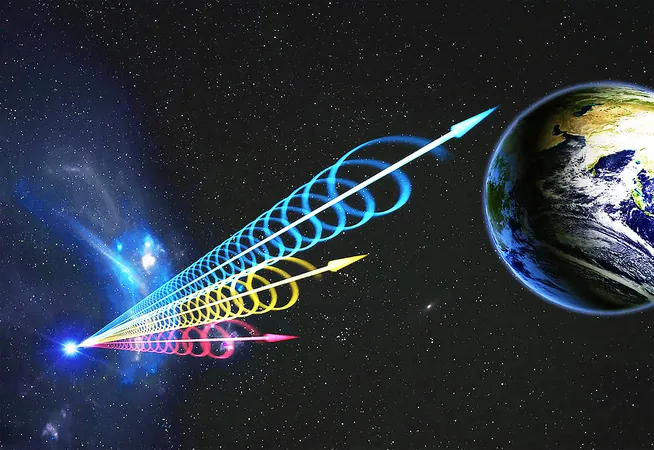
Mysterious 8 Billion-Year-Old Radio Burst Discovered: What It Means for Our Understanding of the Universe
2025-03-26
Author: Wei
Introduction
In a groundbreaking revelation, astronomers have detected an extraordinary burst of radio waves, known as FRB 20220610A, that has traversed the cosmos for an astonishing 8 billion years before finally reaching Earth. This event marks it as one of the most distant and energetic radio signals to date, leaving scientists both amazed and puzzled.
Understanding Fast Radio Bursts
Fast Radio Bursts (FRBs) are brief, millisecond-long flashes of radio waves that emit intense energy. Despite their fleeting nature, the origins of these intriguing phenomena remain elusive, prompting ongoing debates and investigations within the scientific community. Each new discovery surrounding FRBs brings fresh questions, often complicating our understanding of these cosmic signals.
Unveiling the Source
Researchers believe that FRBs could be linked to magnetars, which are highly magnetic neutron stars resulting from the catastrophic explosions of massive stars. To track down this specific burst, the team used the Australian Square Kilometre Array Pathfinder (ASKAP) radio telescope to pinpoint its origin, which was later confirmed using the European Southern Observatory's Very Large Telescope. This astonishing tracking revealed that FRB 20220610A originated from a galaxy older and farther away than any previously identified FRB source.
The discovery was bolstered by the advanced capabilities of the Hubble Space Telescope, which helped determine the precise location of the burst. Lead author, Alexa Gordon from Northwestern University, noted that Hubble's exceptional clarity was crucial in unveiling whether the signal arose from a single galaxy or an interacting system of galaxies. Intriguingly, Hubble's observations suggest that there may be up to seven galaxies in the vicinity that could be merging.
The Search for Cosmic Answers
Co-investigator Wen-fai Fong from Northwestern University emphasizes the need to understand the origins and mechanisms behind these bursts. With Hubble's insights, scientists are closer to discerning not just who or what causes FRBs, but also where they form in the universe.
Interestingly, some researchers propose that FRBs might assist in addressing the long-standing mystery of the universe's 'missing matter.' Current cosmological models predict the existence of much more normal matter than can be observed—around 95% is assumed to be dark matter and energy, remaining undetectable by conventional means. Professor Ryan Shannon suggests that FRBs could act as cosmic probes to detect this elusive matter dispersed in the vastness between galaxies, a relationship established through the Macquart relation, which was founded by the late Australian astronomer Jean-Pierre Macquart.
The Future of FRB Research
With nearly 50 FRBs already traced back to their sources—and ASKAP involved in half of these discoveries—the race is on to explore even more of these cosmic bursts. Experts predict that the construction of new radio telescopes will lead to the detection of thousands more FRBs, significantly enhancing our understanding of the universe's structure.
Professor Shannon emphasizes the potential FRBs have for answering major cosmological questions, indicating that they could provide the foundation for a new cosmic map. As we unravel the mysteries of these powerful signals, we edge closer to understanding the fundamental workings of our universe.
Despite our growing insights, FRBs remain a profound mystery, highlighting just how much we have yet to learn about the cosmos in which we live. Researchers continue to pursue these astonishing natural phenomena, with the tantalizing hope that each new finding brings us a step closer to illuminating the dark corners of the universe.
Conclusion
The full study detailing these revelations was published in the esteemed journal *Science*, further fueling curiosity and research in this captivating field. With every discovery, we are not only expanding our cosmic knowledge but also embracing the immense wonder that comes with understanding our universe.






 Brasil (PT)
Brasil (PT)
 Canada (EN)
Canada (EN)
 Chile (ES)
Chile (ES)
 Česko (CS)
Česko (CS)
 대한민국 (KO)
대한민국 (KO)
 España (ES)
España (ES)
 France (FR)
France (FR)
 Hong Kong (EN)
Hong Kong (EN)
 Italia (IT)
Italia (IT)
 日本 (JA)
日本 (JA)
 Magyarország (HU)
Magyarország (HU)
 Norge (NO)
Norge (NO)
 Polska (PL)
Polska (PL)
 Schweiz (DE)
Schweiz (DE)
 Singapore (EN)
Singapore (EN)
 Sverige (SV)
Sverige (SV)
 Suomi (FI)
Suomi (FI)
 Türkiye (TR)
Türkiye (TR)
 الإمارات العربية المتحدة (AR)
الإمارات العربية المتحدة (AR)